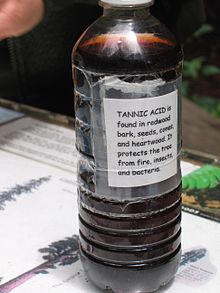Tannic acid

Tannic acid, a commercial form of tannin, is a polyphenol. Its weak acidity (pKa around 10) is due to these phenol groups in the structure. Tannic acid is a basic ingredient in the chemical staining of wood. The tannic acid or tannin is already present in woods like oak, walnut, and mahogany. Tannic acid can be applied to woods low in tannin so chemical stains that require tannin content will react.
Tannic acid is the most common mordant for cellulose fibers such as cotton. Tannin is often combined with alum and/or iron. The tannin mordant should be done first as metal mordants combine well with the fiber-tannin complex.
The presence of tannic acid in the bark of redwood sequoias is a strong natural defense against wildfire, decomposition and infestation.It is found in the seeds, bark, cones, and heartwood.
The chemical formula for commercial tannic acid is often given as C76H52O46, but in fact it contains a mixture of related compounds. Its structure is based mainly on glucose esters of gallic acid. It is a yellow to light brown amorphous powder which is highly soluble in water; one gram dissolves in 0.35 mL of water.
It is said that soaking feet in tannic acid (or strong tea) can help prevent blisters.
But the use of tea for toughening skin appears to be apocryphal, inasmuch as tea is said to be incapable of tanning leather.
Producer
References
The Merck Index, 9th edition, Merck & Co., Rahway, New Jersey, 1976.
